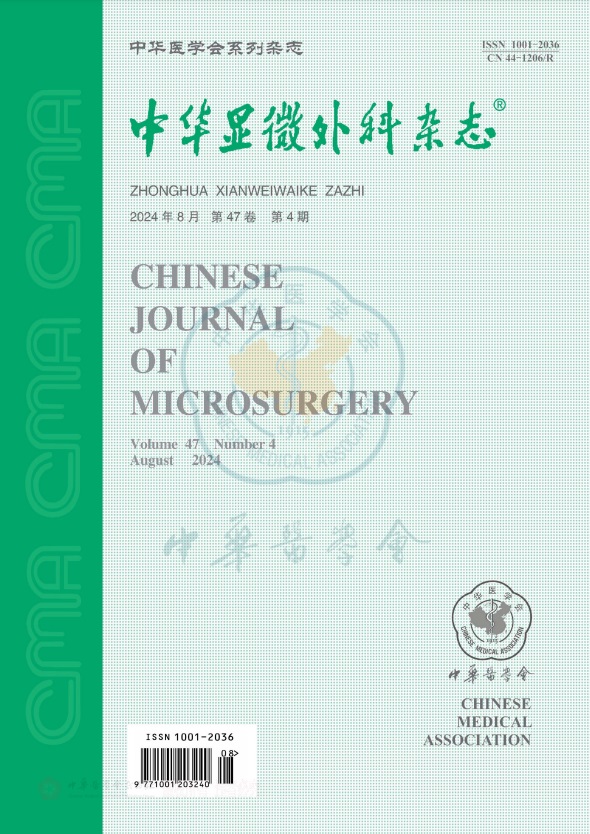The applied anatomy of posterior tibial artery cutaneous branches-chain flap
引用次数: 0
Abstract
Objective To provide anatomy information for harvesting the posterior tibial artery cutaneous branches-chain flaps. Methods The research was performed from January, 2017 to January, 2018. Anatomic observation on 10 legs from fresh human cadaver were performed. The location of cutaneous branches of the posterior tibial artery was observed and its diameter and length was measured. Five legs were prepared to investigate the cutaneous branches of posterior tibial artery. The anastomosis of cutaneous branches of posterior tibial artery was observed by PVA-bismuth oxide perfusion for molybdenum target X-ray arteriography in 5 perfused legs. The cutaneous branches with diameter over 0.2 mm in 10 legs of latex perfusion microdissection were included in the statistical analysis. The data were clustered and analyzed to find the location of distant and near cutaneous branches, which was called the gathering point of cutaneous branch vascular plexus. Secondly, the measured data of distal and near segments containing cutaneous branches were compared by t-test. Then the distribution of cutaneous branches of posterior tibial artery on the tibiofibular side was compared by Chi-square test. It was considered to be significant if P value was under 0.05. Results ①There were 4.3 cutaneous branches raised from the posterior tibial artery. There was no significant difference on the tibial and ribula side distribution of the cutaneous branches from the posterior tibial artery(P>0.05). ②The distal cutaneous branch clusters was located at about 1/5 of the distal leg and there were 3.6 cutaneous branches raised from the posterior tibial artery. While the proximal clusters was located at 1/3 of the proximal leg and there were 0.7 cutaneous branches raised from the posterior tibial artery. There were no significant differences in the diameters (P=0.28) and pedicle length (P=0.14) between distal and proximal cutaneous branches. ③ There were the large cutaneous perforators (≥1.0) mm from the posterior tibial artery at (6.37±1.22) cm proximal to the medial malleolus. The diameter and pedicle length of the distal perforators were (1.11±0.09) mm and (6.53±1.51) mm respectively. ④ The vascular chains parallel to the posterior tibial artery were formed via anastomosis of the adjacent cutaneous perforators. Conclusion The cutaneous expenditure of posterior tibial artery is constant, with a certain pedicle length and diameter. There are 2 relatively dense vascular plexus of cutaneous branches. The proximal and distal vascular flaps can be designed with these 2 vascular dense points as rotation points. Key words: Posterior tibial artery; Cutaneous branches-chain flap; Shank; Applied anatomy胫后动脉皮支链皮瓣的应用解剖
目的为获取胫后动脉皮支链皮瓣提供解剖学信息。方法研究时间为2017年1月至2018年1月。对10具新鲜人体尸体腿进行了解剖学观察。观察胫后动脉皮支的位置,测量其直径和长度。准备五条腿来研究胫骨后动脉的皮支。用PVA-氧化铋灌注钼靶X线动脉造影,观察5例灌注腿胫后动脉皮支的吻合情况。统计分析了10例乳胶灌注显微解剖中直径超过0.2mm的皮支。对数据进行聚类和分析,找出远端和近端皮支的位置,称为皮支血管丛的聚集点。其次,采用t检验法对包含皮支的远端和近端节段的测量数据进行比较。用卡方检验比较胫后动脉皮支在胫腓侧的分布。如果P值低于0.05,则被认为是显著的。结果①胫后动脉有4.3个皮支。胫后动脉皮支在胫肋侧的分布无显著性差异(P>0.05)。而近端集群位于腿近端的1/3处,有0.7个皮支从胫骨后动脉升起。远端和近端皮支的直径(P=0.28)和椎弓根长度(P=0.14)无显著差异在内踝近端(6.37±1.22)cm处,距胫后动脉有较大的皮肤穿支(≥1.0)mm。远端穿支直径和椎弓根长度分别为(1.11±0.09)mm和(6.53±1.51)mm平行于胫后动脉的血管链是通过吻合相邻的皮肤穿支形成的。结论胫后动脉的皮支是恒定的,具有一定的椎弓根长度和直径。皮支有2个相对密集的血管丛。近端和远端血管瓣可以用这2个血管密集点作为旋转点来设计。关键词:胫后动脉;皮支链式皮瓣;柄;应用解剖学
本文章由计算机程序翻译,如有差异,请以英文原文为准。
求助全文
约1分钟内获得全文
求助全文
来源期刊
CiteScore
0.50
自引率
0.00%
发文量
6448
期刊介绍:
Chinese Journal of Microsurgery was established in 1978, the predecessor of which is Microsurgery. Chinese Journal of Microsurgery is now indexed by WPRIM, CNKI, Wanfang Data, CSCD, etc. The impact factor of the journal is 1.731 in 2017, ranking the third among all journal of comprehensive surgery.
The journal covers clinical and basic studies in field of microsurgery. Articles with clinical interest and implications will be given preference.

 求助内容:
求助内容: 应助结果提醒方式:
应助结果提醒方式:


